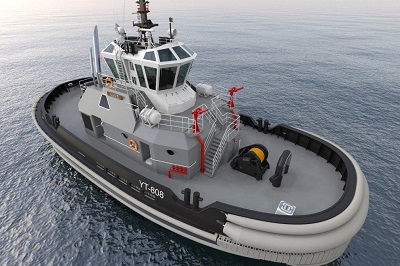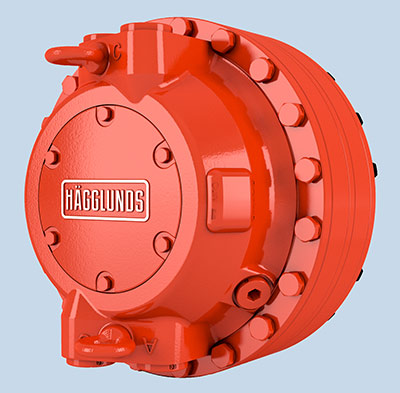In a push toward everything “cutting edge” and “high-tech,” the U.S. Navy in recent years has gone overboard — no pun intended — with the wholesale replacement of proven hydraulic-powered systems with untested electric drives. The results in many cases have been dismal.

The YT-808 tug features hydraulic-powered winch and deck machinery. (Photo courtesy Dakota Creek Industries)
The $13 billion USS Gerald R. Ford aircraft carrier is the most infamous poster child. In June, the Ford had to cut short sea trials and return to port after its Electromagnetic Aircraft Launch System catapult suffered a failure that prevented the carrier from launching planes. And of the Ford’s 11 electric linear-motor weapons elevators, only five are operating. Previous versions were reliable hydraulic units.
Now, the Navy seems to be circling back to systems that actually work.
After unsatisfactory performance issues and premature failures with electric-driven winches, the Navy returned to hydraulic winch systems when it contracted to build a new fleet of service tugs. The first of the new YT-808 series was recently launched by Dakota Creek Industries of Anacortes, Washington. The hydraulic deck equipment and power unit were supplied by JonRie InterTech of Manahawkin, N.J.
For years, JonRie InterTech has provided tugboats, dredgers and other types of vessels with high-performance winch systems built with Hägglunds hydraulic motors from Bosch Rexroth. Extreme torque output, high power density and long-term reliability are key attributes.
Durability, however, is just one side of the Hägglunds motor equation. The other is control, especially when it comes to winch tension. “Tension control is very important in ship docking, for example, where you’re managing the tension that’s between your tug and the ship,” said Brandon Durar, president of JonRie InterTech. “Basically, you set your tension and control it with the Hägglunds motor and the hydraulics, not the brake.”
Besides offering the best possible tension control, Hägglunds motors have free-wheeling capability, and in Durar’s mind the two features are inseparable. To explain why, he describes a tugboat letting out the line as it quickly moves away from its tow, repositioning itself for the next move.
“It’s what I call controlled free-wheeling, which is basically back-tensioning the line a little so that it stays out of the water and doesn’t go slack,” he said. “A tugboat has screws for propulsion, so you don’t want the line in the water at any point. It’s the other aspect of tension control.”

Rexroth-Hägglunds CA motor
As tough and versatile as Hägglunds motors are, JonRie has no difficulties incorporating them into the winches. On the contrary, the motors’ high power density ensures that both power and function can be packed into a limited footprint. JonRie relies mainly on motors from the Hägglunds Compact series, which includes the Hägglunds CA, CB and CBm, as well as the newer Hägglunds CAb.
“Deck space is always at a premium,” said Durar. “The Hägglunds CAb is a very small motor, and we’ve been experimenting with it on our level winds. It’s a nice stout motor in a good little package, and the principle is the same. It takes a licking but keeps on ticking.”
For JonRie customers, the advantages of hydraulics with Hägglunds motors add up to productivity. At the end of the day a boat is an enterprise, and Durar finds that the uptime provided by Hägglunds motors is essential.
“Our customers are sold on the reliability,” he said. “If you’re repairing a winch every four or five years, it’s a budget eater. When you have it in service for 15 years without doing anything to it, it makes you money.” Service on Hägglunds motors is never frequent. If customers filter their oil properly, the motors commonly run for 20 or 25 years, said Durar.
Based on the Valiant class of U.S. Navy Yard tugboats, the YT-808 will be the first of four updated variations built by Dakota Creek Industries. Designed by Robert Allan Ltd., these 90-foot tugs will perform ship-handling duties for the full range of surface warships, barges and submarines. With an updated deck house and new EPA Tier IV engines, the tugs will have a running speed exceeding 12 knots and a bollard pull of 40 tons.
Bosch Rexroth
www.boschrexroth.com
Filed Under: Mobile Hydraulic Tips